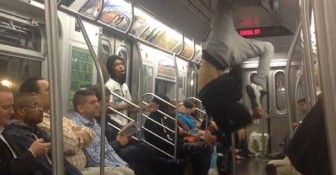
Of the many cultural events I’ve witnessed during the first few months I’ve been in New York, none have been more impressive and unique as the dancers on the subway cars. That’s why it amazes me there is a concerted effort by the city to run them off the trains.
The galleries of the Guggenheim Museum, the landscaping of Central Park and the architecture of the Flatiron building? Truly inspiring. However, for many outsiders, the most compelling cultural phenomenon in the city is the one that many New Yorkers hate: the subway car dancers.
I often take footage of what I see in New York. What I bear witness to, I forward onto friends around the world, who represent many different ages and political and social backgrounds. I don’t want to burst New Yorkers’ bubbles, but the one thing that is truly unique to the Big Apple is the subway car dancers. It is the one thing that my well-traveled friends and family provide most comment on.
“Vibrant,” “amazing,” “athletic” and “I’ve forwarded onto my friends” are comments that I’ve received back, along with questions to me like, “Did you give them any money?” or “How much did they get paid?” I’ve got no doubt that such footage has unknowingly been my most constructive effort at attracting tourists to this city and country.
Besides the dancers’ obvious talents, their entrepreneurial spirit is evident and to be admired. Consider this: All of us from the corporate world know people who are highly paid—who often grew up in the “right” areas, went to the “right” schools—but can’t even stand up in front of a room of people to say a few words. Yet these young dancers have the guts to
put themselves on the line.
So I was perplexed to find out there is a proactive effort by the city to regulate them out of existence.
Leading the charge is the New York City Police Commissioner William Bratton, who after coming into office earlier this year, has aggressively targeted subway dancers. It is part of his “Broken Windows” strategy of policing, which holds that targeting low-level crimes such as dancing on the subway can deter more serious crime.
Yet in this circumstance, this policy is flawed because there is little evidence connecting dancers to deeper misdeeds, as The New York Times has reported. About a fifth of the dancers arrested this year had open warrants, the police said, but few were for serious offenses.
In addition, much comment by those against the dancers centers around people wanting to enjoy their time on the subway cars. This interests me because the first thing I noticed when I traveled on a subway car in New York is how few many people read. It quickly becomes obvious why: One of the oldest subway systems in the world is characterized by noise, jolting of stopping and going, and packed carriages. It is not exactly a meditative space.
Then there is the argument of safety. Commissioner Bratton has said that subway cars are “not for dancing, if you will, no matter how entertaining” because if “one of those kids falls and basically paralyzes himself, you and I will be paying that young man for the rest of his life.”
This position is also undermined by the facts. Not a single instance of injury associated with subway performances has been put forward to justify the crackdown. Robert Cornegy, a Democratic councilman representing Brooklyn, claims there have been no reports of injuries.
Despite this, more than 240 subway performers have been arrested so far this year, four times the number over the same period last year. In addition, the police appear to be ratcheting up their game over the past few months, hitting subway dancers repeatedly with criminal reckless endangerment charges, which require an arrest and can lead to up to a year in jail.
This leads to two questions: Why target an area to increase safety when there have been no reports of injury? Why put so many police resources into a demographic to reduce more serious crime, when it’s known few perpetrators in that demographic have committed serious crime?
If the city wants to improve safety for its constituents, why not lower the speed limit for cyclists riding around Central Park?If noise is the concern, why not regulate against the high-pitched air brakes on the tens of thousands of trucks driving around each day doing untold damage to peoples’ hearing.
It makes more sense to regulate heavily for safety in an area where fatalities and injury are occurring, than in an area where there have been no known reports of any injuries. But kid dancers are an easier target than well-connected parkgoers or trucking companies.
Street culture is what many outsiders think of New York before coming here. The subway dancers are often the centerpiece of witnessing that unique culture. By targeting those performers, New York might destroy what makes it unique and erode the lure for many tourists to come here in the future. That is why banning subway car dancers smacks of class politics, bad economics and poor resource management.








